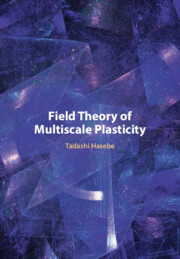Book contents
- Field Theory of Multiscale Plasticity
- Field Theory of Multiscale Plasticity
- Copyright page
- Contents
- Preface
- Acknowledgments
- Part I Fundamentals
- Part II Theoretical Backgrounds
- Part III Applications I
- 9 Identification of Important Scales
- 10 Scale A: Modeling and Simulations for Dislocation Substructures
- 11 Scale B
- 12 Scale C
- Part IV Applications II
- References
- Author Index
- Subject Index
10 - Scale A: Modeling and Simulations for Dislocation Substructures
from Part III - Applications I
Published online by Cambridge University Press: 14 December 2023
- Field Theory of Multiscale Plasticity
- Field Theory of Multiscale Plasticity
- Copyright page
- Contents
- Preface
- Acknowledgments
- Part I Fundamentals
- Part II Theoretical Backgrounds
- Part III Applications I
- 9 Identification of Important Scales
- 10 Scale A: Modeling and Simulations for Dislocation Substructures
- 11 Scale B
- 12 Scale C
- Part IV Applications II
- References
- Author Index
- Subject Index
Summary
As we have seen in Chapter 3, much of the microscopic “specificities” are renormalized into a limited number of degrees of freedom at dislocation substructure scale (Scale A), especially into those with “cellular” morphology, essentially extending over 3D crystalline space. Therefore, as a critical step toward the successful multiscale plasticity, we are required to be ready to answer the following questions about the 3D cell structure; “why do they need the 3D ‘cellular’ morphology?,” “what is the substantial role, especially against the mechanical properties?,” why does the well-documented ‘universality’ manifested as a similitude law, hold?, and “how the microscopic degrees of freedom (information) are stored and when will they be released?” The first goal of this chapter is to derive an effective theory governing the dislocation substructure evolutions, particularly, cellular patterning, from a dislocation theory-based microscopic description of Hamiltonian through a rational “coarse-graining” procedure provided by the method of quantum field theory (QFT) (see Chapter 8). Secondly, after presenting some representative simulation results, an extensive series of discussions on the cell formation mechanisms and the mechanical roles are discussed and identified.
Keywords
- Type
- Chapter
- Information
- Field Theory of Multiscale Plasticity , pp. 483 - 544Publisher: Cambridge University PressPrint publication year: 2024

